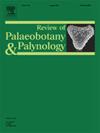Palynology from the Foura Sandstone type section, Timor-Leste, and late Ladinian–Carnian (Middle–Upper Triassic) vegetation reconstruction from NW Australia
IF 1.7
3区 地球科学
Q2 PALEONTOLOGY
引用次数: 0
Abstract
A palynological analysis of the basinal volcaniclastic turbiditic Foura Sandstone Member within the Babulu Formation in Timor-Leste reveals rich assemblages including well-preserved material that correlates with the upper Ladinian–Carnian upper Staurosaccites quadrifidus–?lower Samaropollenites speciosus spore-pollen zones of Australia. The high diversity of conifer pollen in these assemblages indicates an association with microfloras from comparable latitudinal zones within Gondwana and an affiliation with the Onslow paleobiogeographic floral belt. The relationship between pollen and megafloral associations highlights the ecological flexibility of conifers, and their preeminent role in Triassic Gondwanan vegetation. The assemblages from the Foura Sandstone, including the new species Cadargasporites helbyi, Cadargasporites timorensis and Planctonites? comasii, point to the high diversity of vegetation in the area and the need for further studies.
东帝汶富拉砂岩型剖面的孢粉学和澳大利亚西北部晚拉底—卡尼期(中上三叠世)植被重建
对东帝汶Babulu组盆地火山碎屑浊积岩Foura砂岩段进行的孢粉学分析显示,其丰富的组合包括保存完好的物质,与上拉底统-卡尼统上Staurosaccites quadriidus - ?澳大利亚下部Samaropollenites speciosus孢子花粉带。这些组合中针叶树花粉的高度多样性表明它们与冈瓦纳地区类似纬度带的微生物区系有关,并与昂斯洛古生物地理花带有关。花粉与巨型花群的关系凸显了针叶树的生态灵活性,以及它们在三叠纪冈瓦纳植被中的卓越作用。富拉砂岩的组合,包括新种Cadargasporites helbyi、Cadargasporites timorensis和plantonites ?Comasii指出,该地区植被多样性高,需要进一步研究。
本文章由计算机程序翻译,如有差异,请以英文原文为准。
求助全文
约1分钟内获得全文
求助全文
来源期刊
CiteScore
3.50
自引率
21.10%
发文量
149
审稿时长
6 months
期刊介绍:
The Review of Palaeobotany and Palynology is an international journal for articles in all fields of palaeobotany and palynology dealing with all groups, ranging from marine palynomorphs to higher land plants. Original contributions and comprehensive review papers should appeal to an international audience. Typical topics include but are not restricted to systematics, evolution, palaeobiology, palaeoecology, biostratigraphy, biochronology, palaeoclimatology, paleogeography, taphonomy, palaeoenvironmental reconstructions, vegetation history, and practical applications of palaeobotany and palynology, e.g. in coal and petroleum geology and archaeology. The journal especially encourages the publication of articles in which palaeobotany and palynology are applied for solving fundamental geological and biological problems as well as innovative and interdisciplinary approaches.

 求助内容:
求助内容: 应助结果提醒方式:
应助结果提醒方式:


